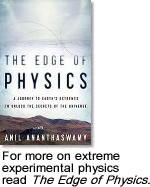India’s giant neutrino observatory gets the nod

Site for the Indian Neutrino Observatory (credit: M V N Murthy)
THE INDIAN NEUTRINO OBSERVATORY received a big boost last week when the Ministry of Environment and Forests gave it formal approval.
The observatory will host a massive neutrino detector, which will include 50,000 tonnes of magnetised iron, making it the largest of its kind in the world. The largest magnet being used in physics experiments today is in the Compact Muon Solenoid (CMS) detector at CERN.
After almost half-a-century, Indian physicists will attempt to get back at the forefront of neutrino physics.
In the 1960s, India hosted one of the world’s first underground neutrino experiments. Called the Kolar Gold Fields neutrino experiment, it was built inside a 2316-metre-deep gold mine in Southern India. In 1965, the experiment became the first to detect atmospheric neutrinos. Here’s a report about the experiment from the CERN website.
Here is my New Scientist story with more details about the Indian Neutrino Observatory.



0 comments
Kick things off by filling out the form below.
You must log in to post a comment.